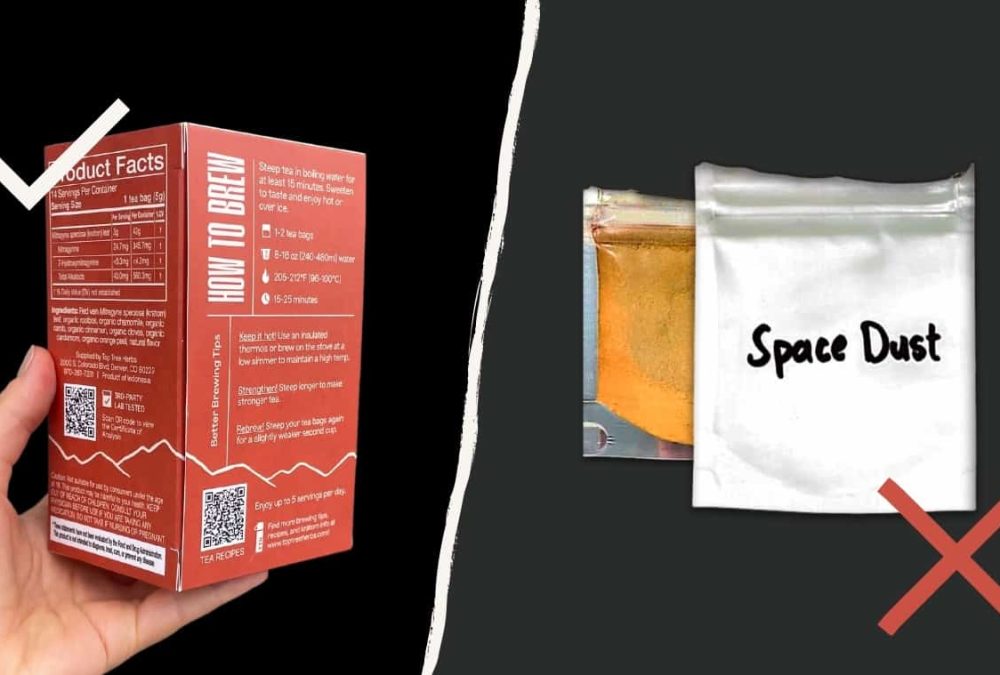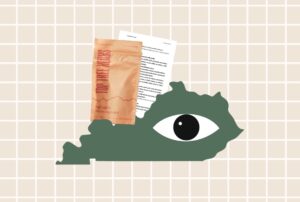The surge in kratom’s popularity within the US, combined with a lack of robust national kratom regulations, has paved the way for a multitude of kratom vendors—each varying in quality—to open up shop. While many of these emergent kratom businesses have rapidly risen to success, others have com tumbling down, sometimes due to entanglements in serious legal battles. It’s no surprise that the kratom lawsuits which have emerged in recent years have been intricate and nuanced.
The Botanic Tonics ‘Feel Free Tonic’ lawsuit in 2023 is just one of the recent kratom lawsuits that have attracted significant media attention. Other cases, such as the Kratom Distro lawsuit involving “Space Dust,” have also captured the attention of kratom consumers throughout the US.
It’s crucial to understand the complexities of these cases and consider how they may reshape the future kratom market in the US—hopefully for the better.
The Basis of the Recent Kratom Lawsuits
So, what’s the deal with the recent kratom lawsuits? What do they mean for kratom consumers and vendors? A few common threads run through the string of recent kratom lawsuits. One of the most significant is improper labeling practices.
We’ve previously talked about how to spot bad kratom vendors to stay away from at all costs. Now, we’re going to get into the nitty-gritty of how to assess a good kratom vendor based on their product labels.
Given that media sources don’t always cover kratom lawsuits thoroughly, we’re here to shed some light on the recent ones. We’re exploring what these lawsuits mean for vendors’ labeling, as well as how the lawsuits & labeling practices affect kratom consumers.
Keep in mind that the following discussion about kratom labeling is not intended to be, nor should it be construed as, legal advice. Our aim with this article is to simply elevate consumer education and promote industry-wide transparency regarding kratom labeling.
We’ll do our best to update the below information labeling regulations as new legislation is passed, but cannot guarantee that it will always be up-to-date. Be sure to consult with a legal professional or relevant authorities for the most current and accurate information.
Improper Labeling of Kratom Products
Deficits in product labeling can cause not just customer confusion, but also significant harm to people and communities. Labeling requirements for kratom don’t exist in all states, and this adds to the confusion for vendors and consumers alike. Yet, regardless of whether or not regulations exist in a particular state, there are ethical reasons that vendors should follow labeling guidelines. This is true for any industry, not just kratom.
To fully grasp the issues brought up by recent kratom lawsuits, it’s essential to first understand the basics of kratom product labeling. Why do product labels matter so much for kratom vendors, and what must labels include to ensure consumer safety?
Providing informative product labels is something that any good kratom vendor should do for their buyers’ safety. Furthermore, states that have regulated kratom have passed laws mandating that kratom vendors follow proper product labeling guidelines. Thus, there are intertwined ethical and legal reasons that all kratom vendors should be employing proper labeling practices.
What to Look for in a Kratom Label: How to Assess the Kratom You Buy
We recommend that kratom activists and consumers everywhere take a close look at the product label on the kratom they buy. When looking at your product’s label, keep an eye out for the following things that a kratom label should include:
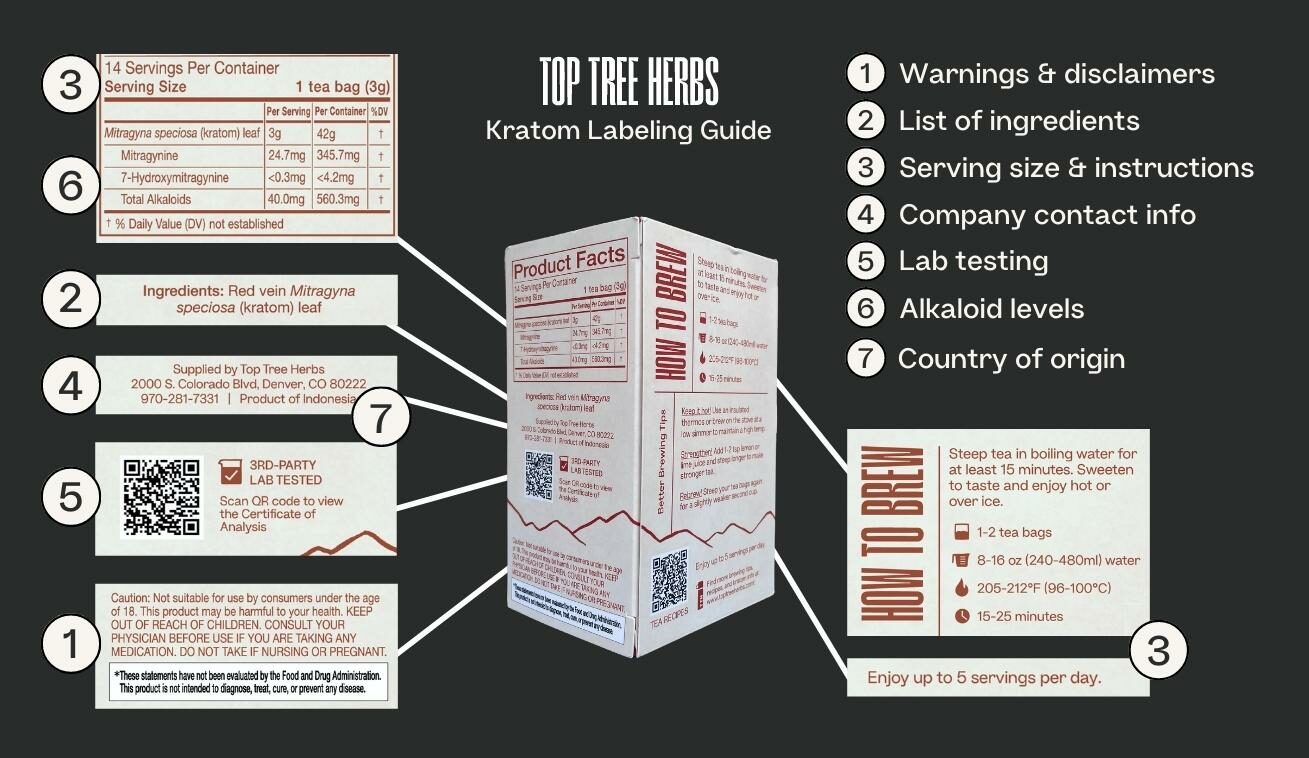
Warnings and Disclaimers:
While kratom consumers often feel very positively about this Southeast Asian plant, kratom is not approved by the Food and Drug Administration (FDA) and still lacks the necessary research needed for approval as a New Dietary Ingredient (NDI). So, mandated warnings and disclaimers about potential risks and interactions are crucial to proper product labeling for kratom.
A Complete List of Ingredients or Additives:
One aspect of proper product labeling involves prominently displaying a complete list of ingredients. Kratom vendors must disclose every ingredient in their product, including any additives or fillers. This is important for individuals with allergies, intolerances, or sensitivities to certain substances. It’s also necessary for adequate consumer transparency. If it’s in the product, it should be disclosed.
Serving Size and Instructions for Use:
To prevent misuse, vendors should provide guidelines for how much kratom to take and how to consume it. Thorough information about serving size and instructions lets consumers know how to properly use the product. Though each person may have a different serving size that best fits their needs, general instructions are still essential. Recommended kratom serving sizes mitigate the possibility of overconsumption and other potential risks.
Company Contact Information:
Every kratom label should include information for contacting the seller and/or manufacturer. A phone number and address on the label are good (and in some states, necessary) components to include. Then, customers will know more about who produced the kratom, and who to reach out to if they have any questions regarding consumption, manufacturing, or other topics. Contact information is a labeling requirement in many states that have passed legislation regulating kratom.
Quality Assurance and Lab Testing:
Unlike the previous four labeling components on the list, it’s currently optional to display the results of lab testing on kratom product labels. Many states do require lab testing for contaminants like heavy metals, E. coli, or Salmonella, as well as alkaloid composition. The lab results are often many pages long, and thus can’t easily be displayed on labels. Instead, companies can provide QR codes or written-out links for customers to follow so that they can view the results of the lab testing elsewhere. After all, third-party testing and other quality assurance certifications can make consumers confident that they are purchasing a reliable product.
Alkaloid Levels or Concentration:
While it’s not currently mandated to include alkaloid content by weight on the product labeling, it’s a good measure to take. At the very least, customers should be able to find out how much mitragynine and 7-hydroxymitragynine is in each product/strain, whether on the website or on the packaging. With kratom extracts, it’s very important to know the concentration (strength) of the extract.
Country of Origin:
Most current KCPA laws don’t require companies to report the country of origin on their products. However, given that most kratom is grown outside of the US, and there is a lot of misinformation about kratom strains circulating in the kratom community, it’s a great labeling component to look for.
As a refresher, #1–4 on this list are the legal minimums that you should be able to find on a kratom product’s label. A few states have proposed legislation to mandate list items #5-7, but such requirements haven’t yet been passed. Nevertheless, there are many reasons that kratom vendors should still include all of these items on the product labels, even in states where kratom is not yet regulated. A kratom vendor will better ensure the safety of their customers with thorough education and transparency.
Many of the recent lawsuits involve kratom extracts of varying strengths. The outcomes of these cases may set a precedent for including extract strength or concentration on the product label. Strength would hopefully be reported in terms of milligrams, as opposed to 5x, 10x, and the like. The latter terms aren’t consistent between producers, so they lack meaning and often confuse customers.
At the very least, you should be able to find out how strong the extract is on the product page of the website. If you can’t, definitely reach out to the vendor to find out how strong your kratom extract is.
As you can see, having proper kratom product labels involves more than just having the strain name spelled out. As you’ll soon find out, product labels are no joke when we cover some recent kratom lawsuits. Having inadequate product labeling is unfair to the consumer and can get a kratom vendor in trouble with the law.
My Kratom Brand Doesn’t Have Proper Labeling. What Should I Do?
So, you opened your package of kratom. You run through the above list of what to look for on the label. Unfortunately, the label is missing one or more of the above elements. What should you do?
To start, you can visit the website of the kratom brand you purchased your product from. Many companies will provide information on their online product pages that they don’t include on their physical products or can’t include due to space restrictions. This is often the case for extracts, which come in very small bottles. At the very least, you should be able to find out how strong the extract is on the product page of the website.
If you can’t find the information you need on the website, definitely reach out to the vendor to find out more. Contact the kratom company by phone or email; hopefully, their contact information is on the product label or on their website. Ask them, “I’ve been wondering what the ideal serving size is,” or “Do you have a full list of ingredients or lab tests available for me to look at?”
Remember that many kratom vendors are small businesses and may need to be made aware they’re missing some label information. That’s not uncommon.
We get it; we’re a small kratom business, too. Yet there’s no excuse for cutting corners when it comes to consumer safety. Properly labeling products with serving sizes and health warnings can mitigate serious risks, so using proper kratom labels isn’t something to downplay or sacrifice for the sake of a budget.
Setting High Standards for Labeling
Our new kratom tea labels go above and beyond KCPA standards, and are informed by many FDA guidelines even though these aren’t mandated. For instance, instead of writing “Less than 2% 7-OH-Mitragynine” on the label, we now report the actual amount in milligrams for each serving and for the entire package.
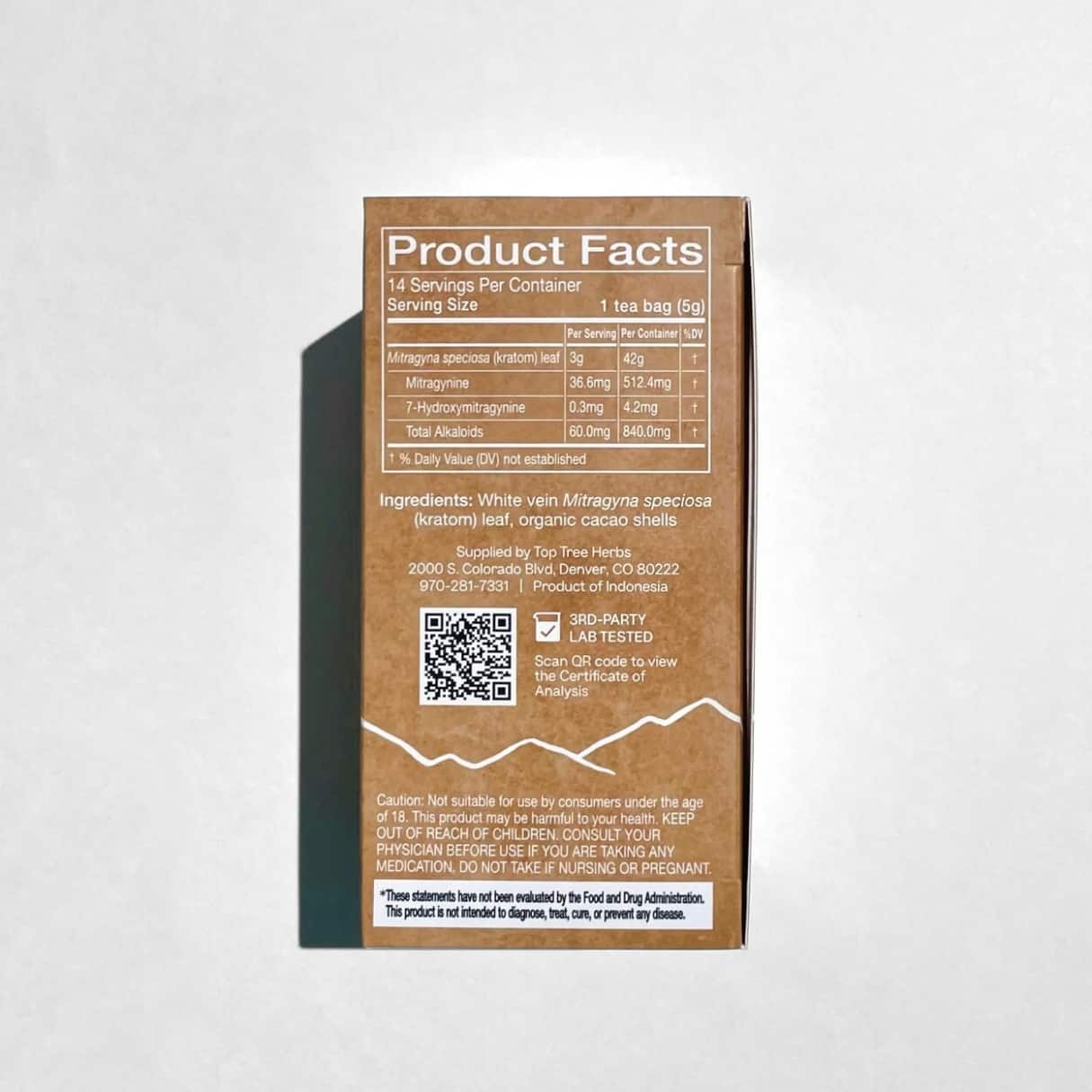
Feel free to use our product labels as a standard to go by for what kratom labeling should look like when assessing another product. In light of the current controversies and misinformation surrounding kratom, customers should be discerning and look for companies who do things right.
When it comes to product quality, we go above and beyond the Good Manufacturing Practice (GMP) standards. We provide up-to-date lab tests on all of our products and are thorough and transparent in our labeling.
To see our lab tests, you can easily find our kratom Certificates of Analysis (COAs) for each product we offer, or, if you have a box of our premium kratom tea on hand, you can use the QR code on our product labels to visit our lab testing page.
Why Do Kratom Vendors Get Sued? An Overview of What Leads to Kratom Lawsuits
To better understand the recent kratom lawsuits in 2023 and previous years, you may want to know why kratom vendors get sued and where labeling fits in.
Several issues commonly prompt lawsuits against kratom vendors. Kratom businesses caught in the crosshairs of lawsuits often have to defend themselves against multiple claims of legal non-compliance.
We’ll expand on the most important takeaway of recent kratom lawsuits soon, but first here’s an overview of some common reasons why kratom businesses find themselves in court:
1. Kratom Sales in Illegal States
An easy way for a kratom vendor to face a lawsuit is by making kratom sales in states where kratom is banned. While kratom is legal in most states in the US, a handful of states, counties, cities, and towns have banned the sale or purchase of this Southeast Asian plant.
Additionally, buying kratom in an illegal state — or buying kratom in a legal state and transporting it to an illegal one — can result in hefty fines, jail time, and possible felony charges.
A good kratom vendor knows not to ship kratom to states where kratom is scheduled. Conversely, careless or absentminded vendors might make such a mistake, putting themselves at risk of legal repercussions.
2. Adulteration, Contamination, and Lack of Quality Control
A good kratom vendor knows to have all of their products tested in a lab to determine their purity and alkaloid content.
However, kratom is not regulated at the federal level, and the state-level regulations vary greatly. The lack of standardized manufacturing processes and quality control means that a lousy kratom vendor might neglect to put in effort to ensure the quality and purity of their products.
Kratom products that have been adulterated with other substances or contaminated with mold or E. coli are a significant safety hazard. Such issues in quality control may cause some consumers to experience adverse effects, such as allergic reactions, digestive problems, or even more severe health issues.
In such cases, it’s no wonder why customers may decide to sue vendors for negligence or inadequate quality-assurance practices.
3. Adverse Effects from Products
Although people have consumed kratom for centuries (if not millennia), the lack of regulation in the US—combined with a growing range of non-traditional, highly concentrated kratom products —has introduced potential risks. These problematic kratom products have become the norm in many places, and traditional methods of consuming kratom are not commonly practiced in the US.
Reports of adverse health effects have raised concerns among authorities and the public. When individuals experience adverse health outcomes after consuming kratom products, they might seek legal recourse by suing vendors for negligence in labeling measures or for producing unsafe products.
4. Misleading Marketing and Claims
Given that kratom is not regulated or approved by the Food and Drug Administration (FDA), kratom vendors are limited in how they can market kratom. It is against the law for kratom vendors to make any claims about health benefits or medical uses.
Not only is it illegal to make these claims, but making them can hurt a vendor’s relationship with their customers and damage the greater public perception of kratom.
FDA Warning Letters Prior to Kratom Lawsuits
Often, the FDA will first send warning letters to companies using forbidden marketing claims. For example, Kratom Spot received a warning letter from the FDA regarding the use of illegal medical claims. In this instance, the medical claims had been written and published by a third party hired by the vendor.
After receiving the warning letter, Kratom Spot, who never meant to mislead anyone, promptly removed the problematic claims, and no further legal action was required.
However, if a kratom vendor fails to remove these claims or gets caught up in another legal issue, they can wind up on the receiving end of a lawsuit. Kratom consumers and sellers must understand what kratom vendors can and can’t say when marketing kratom.
5. Labeling and Packaging Issues
As you now know, accurate labeling and clear packaging are crucial for any consumer product, especially kratom. Incorrect or insufficient labeling (including inadequate information about serving size, instructions for use, company contact info, and warnings) can potentially lead to customers misusing the product or consuming too much, and consequently facing adverse effects.
Thus, when consumers face adverse effects due to incorrect product information or unclear instructions, they have every right to file a lawsuit.
6. Copyright Infringement, Company Licensing, and Other Business Matters
While business licensing, trademarks, and copyright infringement do not make as big of a splash in the media, these are all issues that can result in a person or business filing a lawsuit against a kratom vendor.
In some instances, kratom companies sue each other over business transgressions. For example, the kratom vendor Vivazen Botanicals sued Bliss Nutraceticals, another kratom business, for infringing on their “VIVAZEN” trademark.
Many of the same things that can get any company in trouble with the law also lead to kratom lawsuits. However, the fact that the FDA has not regulated kratom or enforced consequences for illegal business actions as it has for other products may be a significant factor in why kratom-related cases arise. It’s the reason why poorly manufactured or produced products reach the market in the first place.
Now that we’ve covered what to look for in a kratom label and some reasons why kratom vendors face lawsuits, let’s discuss some recent examples of kratom lawsuits and how product labeling comes into play.
Recent Kratom Lawsuits Prove The Importance of Labeling
In this section, we’ll highlight the impact of product labeling deficiencies in three specific kratom lawsuits:
- Botanic Tonics: Torres v. Botanic Tonics, LLC et al
- The Kratom Distro: Devin Filippelli v. Grow, LLC et al
- OPMS Kratom: civil action, Pope family v. OPMS, and class-action C.B. v. Martian Sales, Inc.
- Kratom Divine: Sybil Coyne, Et Al, Appellants V Wendianne Rook, Et Al, Respondents (Majority)
We’ll use these cases to explain why we believe proper labeling is a critical factor in ensuring consumer safety and thus, a critical factor in the prevention of tragic losses that may result in kratom lawsuits.
1. Botanic Tonics’ Feel Free Tonic Lawsuit
Since we’ve already gone in-depth about the Botanic Tonics “Feel Free” kratom drink lawsuit, we’re only going to summarize this case briefly here.
This class-action kratom lawsuit (Torres v. Botanic Tonics, LLC, et al), involved complaints against defendant Botanic Tonics. The plaintiff was affected by their Feel Free drink’s marketing and labeling practices. The Feel Free tonic, marketed by Botanic Tonics as a “wellness drink,” contained kratom and kava.
The problem? Customers weren’t actually aware that Feel Free contained kratom.
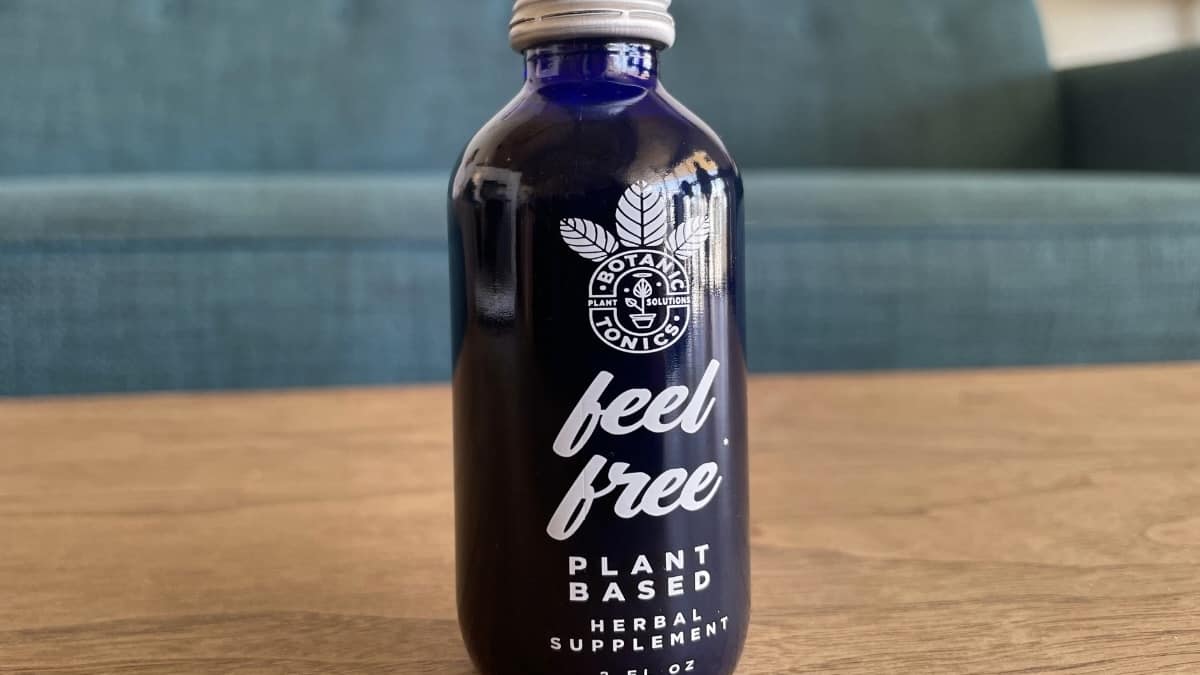
Feel Free didn’t divulge this to the public, which is especially concerning given that the tonics may have contained highly concentrated kratom. Instead, Botanic Tonics marketed Feel Free as a drink containing “kava and other ancient plants.”
Feel Free’s Labeling Omissions
They only explained that the Feel Free tonic contained kratom in an image of their ingredients lists which could be found on the FAQ page of the website, so the information was not readily accessible to customers. Plus, they never disclosed the amount of kratom in each serving size.
In the complaint for damages in this class-action kratom drink lawsuit, the prosecution states,
“Unbeknownst to Plaintiff, undisclosed by any of Botanic Tonic’s extensive marketing and advertising, and undisclosed by the label on the product, Feel Free’s primary ingredient was kratom. Plaintiff did not know, and could not have known, that there was more than twice the amount of kratom in Feel Free as there was kava, and that Botanic Tonics had formulated the product to magnify the effects of the kratom.”
This lawsuit against Botanic Tonics commonly appears in the media as a kratom addiction lawsuit. In truth, this is not surprising given that Botanic Tonics not only neglected to inform their consumers about the full list of ingredients in their tonic, but also targeted customers looking for a sobriety-friendly drink.
In short, due to their utter lack of consumer transparency, poor conduct, and misleading practices, Botanic Tonics is definitely on the list of kratom vendors to be wary of.
2. The Kratom Distro “Space Dust” Kratom Lawsuit
The Feel Free tonic class-action lawsuit wasn’t the only head-turning kratom lawsuit in 2023. While the Botanic Tonic’s Feel Free case fired up the media in the spring of 2023, another kratom lawsuit—this time, against The Kratom Distro—soon followed. The Kratom Distro (and its parent company, Grow LLC) gained media attention due to the lawsuit in June of 2023.
Unlike the Feel Free case, which was a class-action lawsuit, the Kratom Distro lawsuit took a different form. Specifically, the case of Devin Filippelli v. Grow, LLC et al was framed as a wrongful death lawsuit and a product liability action. The defendants named in the case were Grow, LLC (the parent corporation behind KD Incorporated and The Kratom Distro), as well as Sean Michael Harder, the owner of The Kratom Distro.
The plaintiff, Devin Filippelli, represented the Estate of Krystal Talavera. Krystal, Devin’s mother, died in June of 2021. Krystal had consumed Kratom Distro’s “Space Dust,” among other Kratom Distro products.
The Kratom Distro lawsuit is in large part about product labeling. The plaintiff claimed that the Kratom Distro products that Krystal Talavera received in her shipment, “were adulterated, misbranded, lacked warning labels, dosage instructions, and carried serious risks.”
What is “Space Dust Kratom?” Kratom Distro’s Infamous Product
A product that keeps appearing in media coverage of the Kratom Distro lawsuit is “Space Dust.” It used to be one of the vendor’s popular proprietary products. So, what is “Space Dust kratom,” and why is it mentioned in the lawsuit?
Ever since the lawsuit, Kratom Distro has taken down its “Space Dust” kratom product page (and despite our efforts with the WayBack Machine, we couldn’t find the original listing). Regardless, given that the product was not labeled properly to begin with, it would have been difficult to know what was in Kratom Distro’s Space Dust.
For all we know, the “Space Dust” kratom “strain” could’ve contained wood chips, incense, or even literal space dust—we can’t be sure. We do know for certain that Space Dust contained more than just plain-leaf kratom. At the very least, it was a highly concentrated extract.
Reviews of Space Dust Kratom
In our deep dive to learn more about Kratom Distro’s Space Dust product, we found this brief Kratom Distro review on Quora under a post titled, “Where do I get kratom that will have an actual impact?…” Here’s what one response said:
“…The website is called Kratom Distro – The Last Kratom Source You’ll Ever Need! They do away with that confusing 10x, 20x, 50x nonsense, which means nothing anyways. You can have a 10x stronger than a 20x, etc. And instead uses actual percentages of alkaloids, for both mitragynine as well as a general percentage of all alkaloids combined. Their strongest item, called Original Space Dust contains a whopping 29%. Compared to plain leaf, which varies around 1%-2% and most extracts which vary between around 5% and 15%, this stuff is mana from heaven.”
Now, if someone happened to be looking for kratom that would “have an actual impact,” it’s not surprising that they would receive responses about extracts. Unlike kratom tea and raw leaves—which have been consumed in traditional settings for centuries—kratom extracts contain a highly concentrated amount of alkaloids.
Knowledgeable kratom consumers know that the strength of a kratom extract can vary significantly between products, and many reports of adverse effects are associated with highly concentrated kratom extracts.
Because of this, the adage “less is more” is often repeated in the kratom community. Many people don’t want to consume the strongest extracts, which, unlike kratom tea, have only a short history of consumption. For the same reason, a number of people are more interested in microdosing kratom than consuming extracts.
What Botanic Tonics’ and The Kratom Distro’s Products & Kratom Lawsuits Have in Common
Unfortunately, both Botanic Tonics and Kratom Distro made it impossible for their customers to know just how much kratom they were consuming, which is unfair to anyone who wants to avoid overconsumption.
Part of the problem with kratom shots is that it’s hard to know just how strong a given kratom extract shot is. Not all vendors do their due diligence by testing the alkaloid levels for each batch and then making the exact concentrations available to consumers.
Without proper lab testing and standardized labeling, consuming kratom extract drinks or extract powders like Space Dust could be a shot in the dark. You might not know how a serving of extract compares to that of kratom tea or other less-concentrated kratom products. A single serving of an extract with an unknown concentration could be far stronger than your average serving of plain-leaf kratom tea.
Kratom Distro Lawsuit Problems Part I: Inadequate Product Labeling
The amended complaint filed for the lawsuit repeatedly claims that The Kratom Distro consistently sold products (including Space Dust) without any instructions regarding instructions for use, recommended serving size, or a warning about known risks of the products.
The lawsuit states that according to the Federal Food, Drug, and Cosmetic Act (FDCA), a food shall be deemed misbranded if:
“‘(1) its labeling is false or misleading in any particular, or (2)…its advertising is false or misleading in a material respect or is in violation of Section 350(b)(2)4 of this title.’ 21 U.S.C. § 343(a).”
A packaged food is also considered misbranded unless it has a label containing the following:
“‘(1) the name and place of business of the manufacturer, packer, or distributor; and (2) an accurate statement of the quantity of the contents in terms of weight, measure, or numerical count.’ 21 U.S.C. § 343(e).”
What did the Kratom Distro Product Packaging Look Like?
How did Kratom Distro actually package Space Dust, G2, G4, and G5?
The Kratom Distro products that Krystal Talavera received each came in a resealable bag with the kratom “strain” or extract name written on it.
The packaging didn’t display any company contact info, list of ingredients, or instructions for use. (As an aside, if you’re wondering why we used kratom “strain” in quotes, check out our post on doing away with the deceptive marketing of kratom strains).
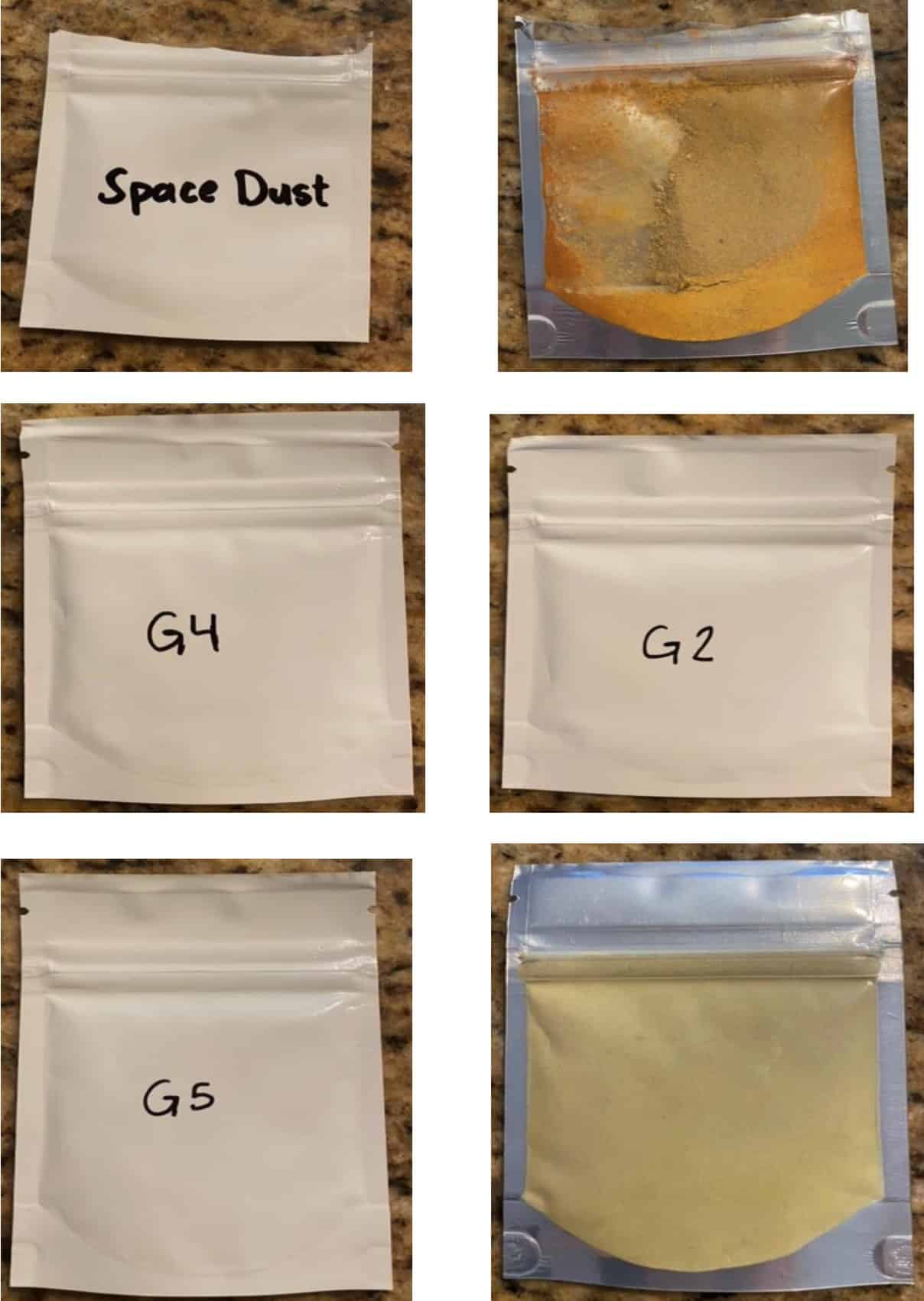
Above, you can see the names “Space Dust,” “G2,” “G4,” and “G5,” each presumably written with a permanent marker. These labels were meant to represent “Space Dust,” “Green Maeng Da,” “Green Horned Maeng Da,” and “Green Riau,” respectively.
The photos show the very minimal labeling on these products; minimal really feels like an overstatement here. It’s clear that these Kratom Distro products violate many states’ KCPA regulations, and would be considered misbranded according to the FDCA statutes.
Health Claims on The Kratom Distro’s Website
On top of the packaging issue, the company also made unapproved health claims about the benefits of kratom. While these claims don’t appear on the packaging itself, they can still be considered part of the products’ labeling under some FDCA guidelines; more on these misleading marketing claims below.
In the lawsuit complaint, the plaintiff states that, “Without proper warnings and instructions, the kratom products [bought from Kratom Distro] were unreasonably dangerous, unfit for their intended use, and highly dangerous and defective.”
Based on the lack of labeling, the plaintiff argues that, “An ordinary consumer would reasonably conclude that GROW, LLC’s and HARDER’s Kratom products are unreasonably unsafe when sold without warnings or instructions about the serious adverse health risks, including the risk of overdose and death suffered by Krystal.”
Kratom Distro Lawsuit Problems Part II: Marketing
In addition to citing issues with labeling Space Dust kratom and other products, the Kratom Distro lawsuit also references the company’s alleged issues with marketing.
For example, the complaint posits that Kratom Distro and Grow, LLC, “advertise their strains of Kratom to: treat pa**s and other discomforts; have a eu****ic effect; and provide relaxation and ene**y.”
The lawsuit complaint also states that Kratom Distro described their products as, “very effective pa** relievers, ene**y boosters, and a sense of eu****ia” in their Kratom Strain information (obfuscation has been applied to prevent any unintentional promotion or endorsement of health claims, and to ensure our own compliance with regulations regarding content searchability).
As of August 2023, such claims are still posted in the “Strains” section of the Kratom Distro website. FDA laws strictly prohibit any health, structure/function, and medical claims. Kratom Distro would thus be in clear violation of these restrictions for making such claims.
3. OPMS Lawsuits
The two lawsuits filed against OPMS Kratom are quite complex. Both include allegations that OPMS has insufficient or misleading information on their product labels. Both also make broader claims about the kratom plant and identify a perceived lack of consumer education throughout the kratom community.
In the lawsuit filed by the family of Ethan Pope, the Plaintiffs included the American Kratom Association (AKA) in their list of defendants.
The American Kratom Association has OPMS at the top of their list of GMP-Qualified vendors, and the Plaintiffs claim that OPMS never actually met the requirements set by the AKA or the Georgia Kratom Consumer Protection Act regulations.
4. Kratom Divine Lawsuit
The Kratom Divine lawsuit didn’t draw as much attention as the previously mentioned lawsuits. Regardless, it’s an important example of the serious impact of labels and marketing that we can learn from. It’s similar to the Kratom Distro lawsuit in that the defendants were sued for negligence leading to a wrongful death.
In this case, Patrick Coyne’s Estate representative, Sybil Coyne, filed a suit against the company behind Kratom Divine, Society Botanicals LLC. While it’s easy for the media to demonize the kratom plant itself in these kinds of lawsuits, the primary issues addressed by this case are negligent labeling and deceptive marketing.
The plaintiff’s complaint included claims about Kratom Divine’s deceptive marketing tactics. The plaintiff also argued that the kratom product was adulterated and did not meet proper manufacturing standards for purity and safety.
The Superior Court of Washington’s ruling on this case was that Kratom Divine/Society Botanicals had insufficient and misleading product labeling. In the summary judgment, they found that, “There is no question of fact that Society presented marketing materials through its website promoting the use of Kratom to address a variety of medical or psychological maladies… There is no question of fact that Society’s labeling (i.e., warnings and instructions) on the Kratom Divine product was deficient...“
As was the case in the Kratom Distro lawsuit, Kratom Divine was accused of having deceptive and unlawful promotional statements on its website, as well as in other advertising resources, including an ebook. The complaint asserts that Kratom Divine neglected to offer appropriate product cautions and even drew parallels between their items and medical therapies in their marketing materials.
Kratom Divine Lawsuit: The Ruling
In the final outcome of this kratom lawsuit, Society Botanicals/Kratom Divine was found to have inadequate warnings and instructions on Kratom Divine products. However, ultimately, the Court denied the plaintiff’s motion.
Being a partial summary judgment, it did not address a few of the case’s other elements, including causation and damages.
How Kratom Lawsuits Demonstrate the Dire Need for Regulation
The legal status of kratom varies across different states and regions. While kratom isn’t regulated at the federal level, many states have enacted laws like the Kratom Consumer Protection Act to regulate kratom within their borders. This legislation contains a set of regulatory guidelines introduced by the American Kratom Association.
Related: Guide to Kratom Age Limits and Regulations in All 50 States
The most reputable kratom vendors support the Kratom Consumer Protection Act (KCPA) and kratom regulation as a whole. Such vendors often prioritize consumer safety over profit; they want to improve the entire industry despite the increased financial burden of regulation.
Many of these vendors follow all of the necessary precautions for manufacturing standards, lab testing, and labeling practices—even when selling kratom in unregulated states, where these measures are not required by law.
Enforcing Good Kratom Labeling Practices through FDA & KCPA Regulation
State kratom regulation bills (both the KCPA and other similar government-written bills) typically include mandates for proper product labeling. A few of these bills also provide means for enforcement of these mandates.
Ideally, kratom should be regulated, and every kratom vendor should take every precaution necessary to ensure product transparency for the safety of their consumers. Most other industries have clearly defined and enforced safety requirements, and kratom should be no different.
2023 Consumer Advisory from the American Kratom Association
The American Kratom Association has continued their efforts to urge the FDA to regulate kratom, as well as inform consumers of how to protect themselves given the current lack of regulation.
On July 31st, 2023, they issued a Consumer Advisory addressing the kratom community and the FDA. In the advisory, they urge the FDA to create official product manufacturing standards for kratom products. They also request enforcement and removal of products that don’t have proper labeling components.
Next, the AKA addressed consumers. They advise all kratom consumers not to purchase any product that is:
- Not tested and certified as free of dangerous contaminants or adulterants by an independent laboratory;
- Marketed or labeled with any illegal therapeutic claims;
- Missing contact information of the distributor (meaning a consumer would not be able to file an adverse event report to the company or FDA);
- Lastly, comes in an “unprofessional package,” such as a ziplock bag or a container with handwritten product information.
Unfortunately, until kratom is regulated either federally or in all 50 states, kratom lawsuits may continue to grow in frequency—at least until more vendors voluntarily improve their labeling practices and quality standards.
A Message for Kratom Consumers and Vendors
Whether you’re a kratom consumer, an activist, or a kratom vendor yourself, we hope the above discussion has provided insight into the importance of labeling.
Kratom package labeling can make or break a company; it can either garner customer trust or instill confusion. Providing informative, transparent labeling on kratom products is crucial.
Transparent and accurate labels provide essential information about serving sizes and instructions for consumption. They help users make informed decisions, reducing the risks associated with improper consumption.
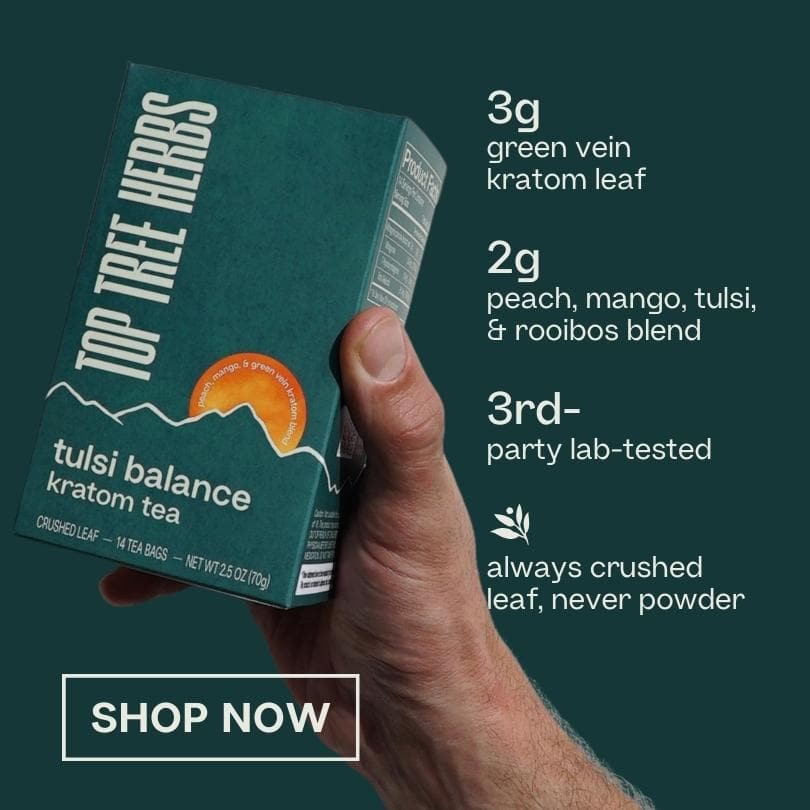
By adhering to stringent labeling regulations—even when not required by federal or state law—kratom businesses may prevent potential lawsuits and protect consumers from misinformation.
Aside from producing high-quality and unadulterated products, improving product labeling is one of the most important things a kratom vendor can do.
When searching for a trustworthy vendor, the most important factor isn’t how ‘fire’ their kratom strains are; it’s what that kratom vendor is doing to ensure Americans’ ability to have a positive experience with kratom now and in the future.
How Can Kratom Tea and Transparent Labeling Help Change Public Perception?
In an industry where consumer well-being is paramount, we at Top Tree Herbs do everything possible to promote business transparency and consumer education. We do this to provide customers with the best possible kratom experience, not just in the short term, but in the long term, too.
We think there’s no better way to normalize kratom than by selling premium kratom tea bags. Unlike kratom extracts and powders, kratom tea is a traditional form of consumption.
People in Southeast Asia have consumed kratom tea for hundreds, if not thousands, of years, whereas other types of kratom products, such as extracts and powders, have only been around for a few decades.
If you prefer to stick with something that has a great track record, kratom tea bags are the perfect option.
To learn more about our traditional kratom tea company and what we do, check out our kratom story and browse other informative kratom news articles on the Better Brewing Blog.
One final reminder: the above information isn’t meant to be legal advice, nor should it be construed as such. We’ve provided this information in an effort to improve the kratom industry and kratom consumers’ experiences. Many people can greatly benefit from kratom, but only if they have all of the information they need to consume it properly and safely.
